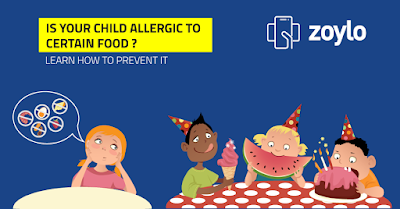You might come across a panic situation with your child who just ate something and started experiencing discomfort, dizziness, vomiting, rashes or similar other reactive symptoms. When you are not sure what your child is allergic to, you might not guess that these symptoms are a signal towards food allergy. While some kids can show food allergies’ symptoms within few minutes, others may take two to four hours as well to react to a certain food.
You might end up feeding your child same thing again if you are not aware that your child is allergic to that food item.
90% of Food Allergies are caused by 8 types of food.
- Egg
- Milk
- Peanuts
- Tree nuts
- Fish
- Shellfish
- Wheat
- Soy
Food allergy rash in small babies can be severe with intense redness and itching. If your child is also witnessing similar condition, going for an allergy test is suggested so that you can be aware of what to avoid.
How to diagnose a food allergy?
To diagnose a food allergy, doctor might take your food history and family history to discover any correlation. How long your child took to show the symptoms, for how long they lasted, and what and how much quantity was eaten are a few questions that much be tracked and recorded.
For specific diagnosis of food allergy and allergy treatment, skin-prick test and blood tests are done to find out exactly which food is causing the allergy.
What Happens in a Food Allergy?
In food allergy, the body reacts to a food as if it is harmful to the body. The immune system produces antibodies to fight the food allergen and this internal combat is reflected in the form a number of allergic symptoms.
How to Manage Food Allergies in Kids?
The primary way to manage a food allergy is to avoid the food that triggers the symptoms. Other things that you can do are following:
- Read carefully the ingredients and avoid if the allergic food is a part of some other packaged food item.
- Be extra careful while eating out and give specific instruction to the waiter as what to avoid in your food.
- For life-threatening food allergies, seek medical help and doctor might prescribe epinephrine auto-injector. This auto-injector should always be kept handy.
- Give special instructions to your child’s care taker, school teachers and others with whom your child spends time.
- In school, teachers and field instructors should have knowledge of how to identify the symptoms of food allergy in your child.
- If your child is diagnosed with an auto-injector, teachers and child’s care taker should be aware of how to use it and when to use it.
There is research going on to minimize food intolerance and build tolerance to allergic food. It is also possible that your child might develop resistance to allergic food at some later stage of life. However, you should be careful enough to avoid these foods to prevent any panic situation at home or outside.
Advertisement






EmoticonEmoticon